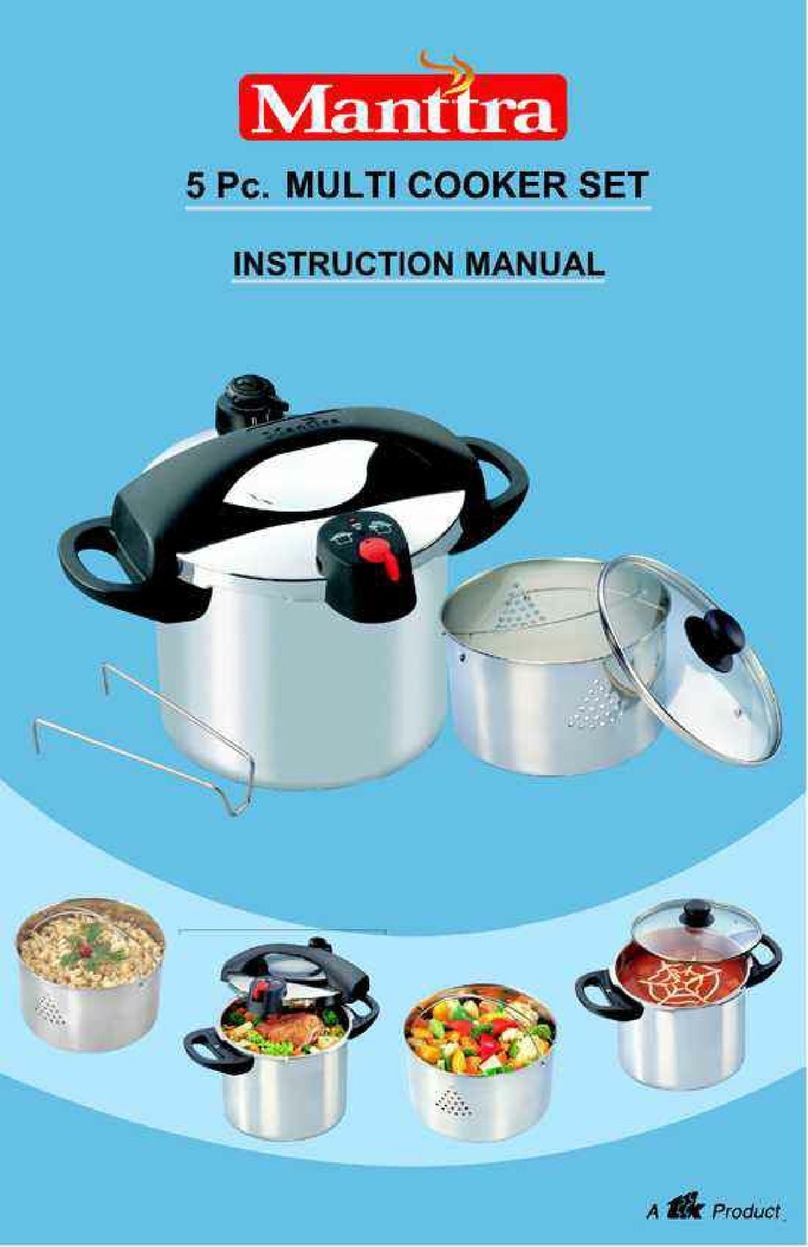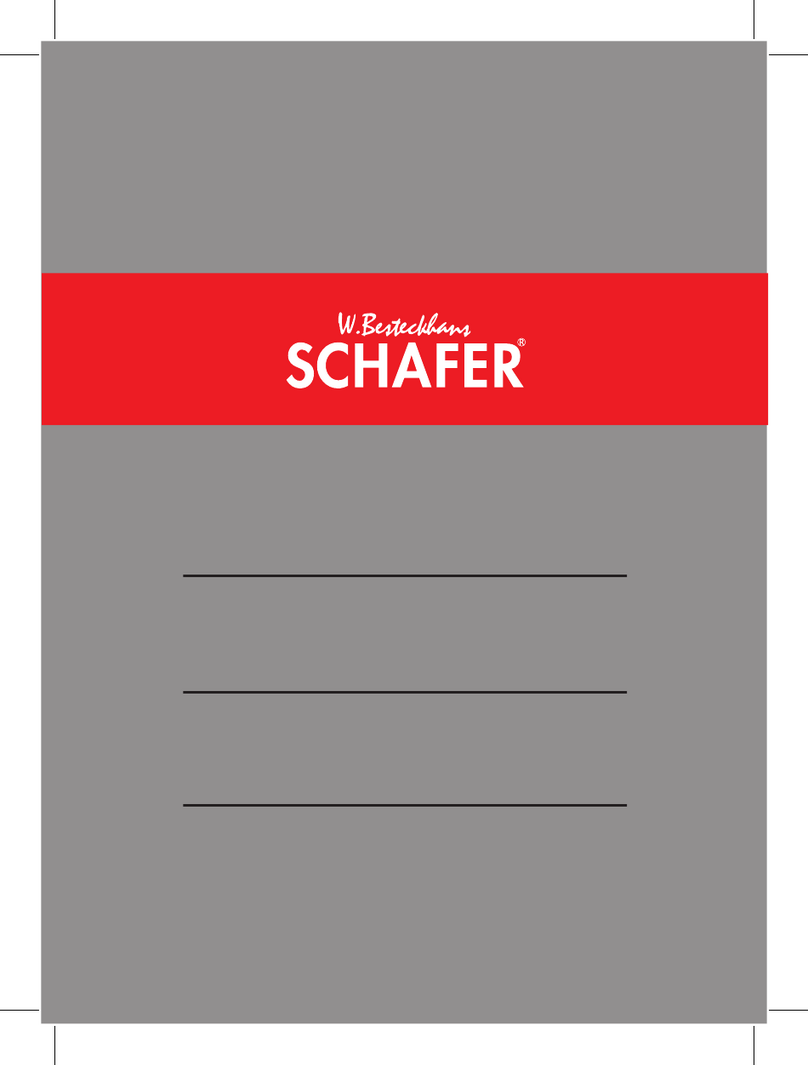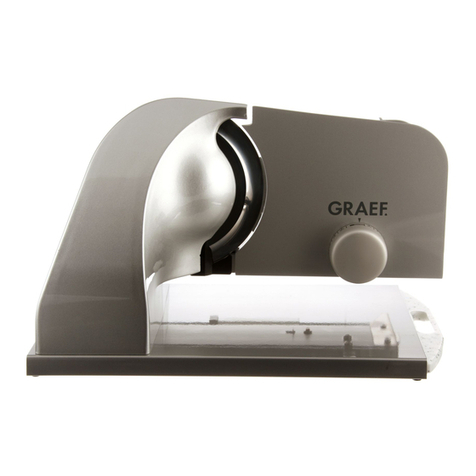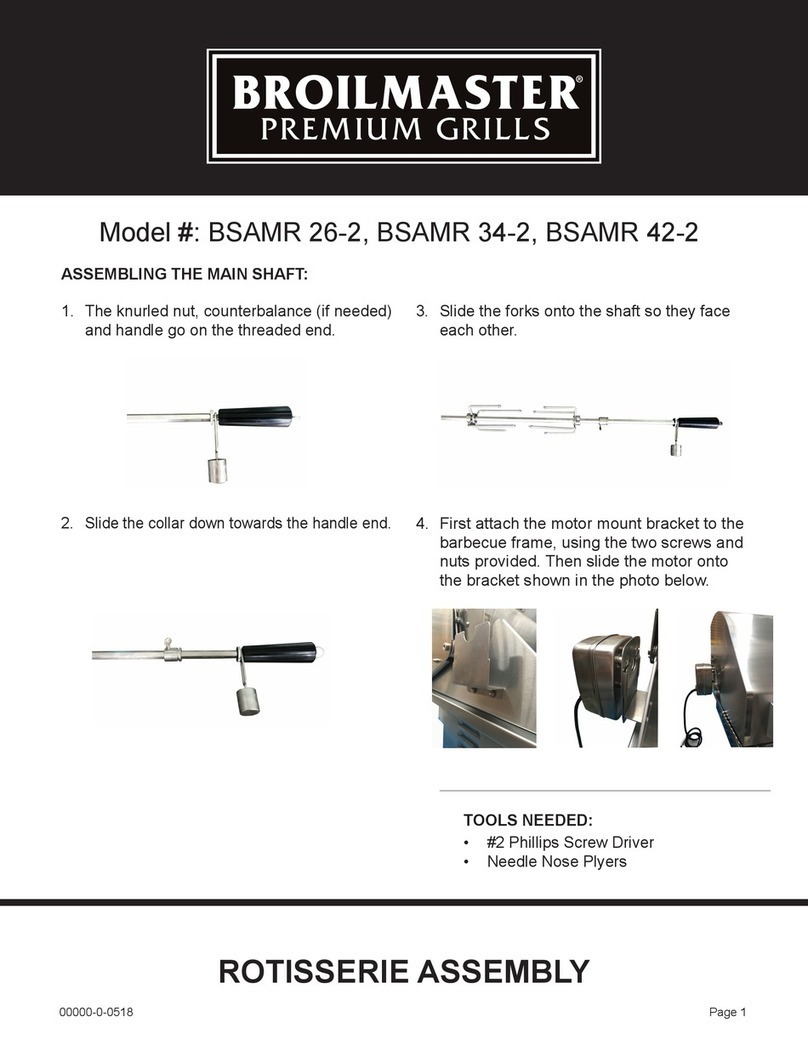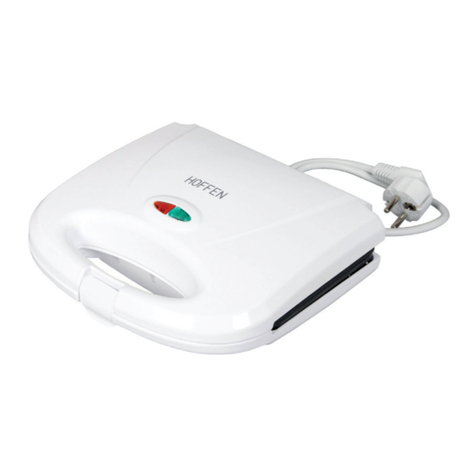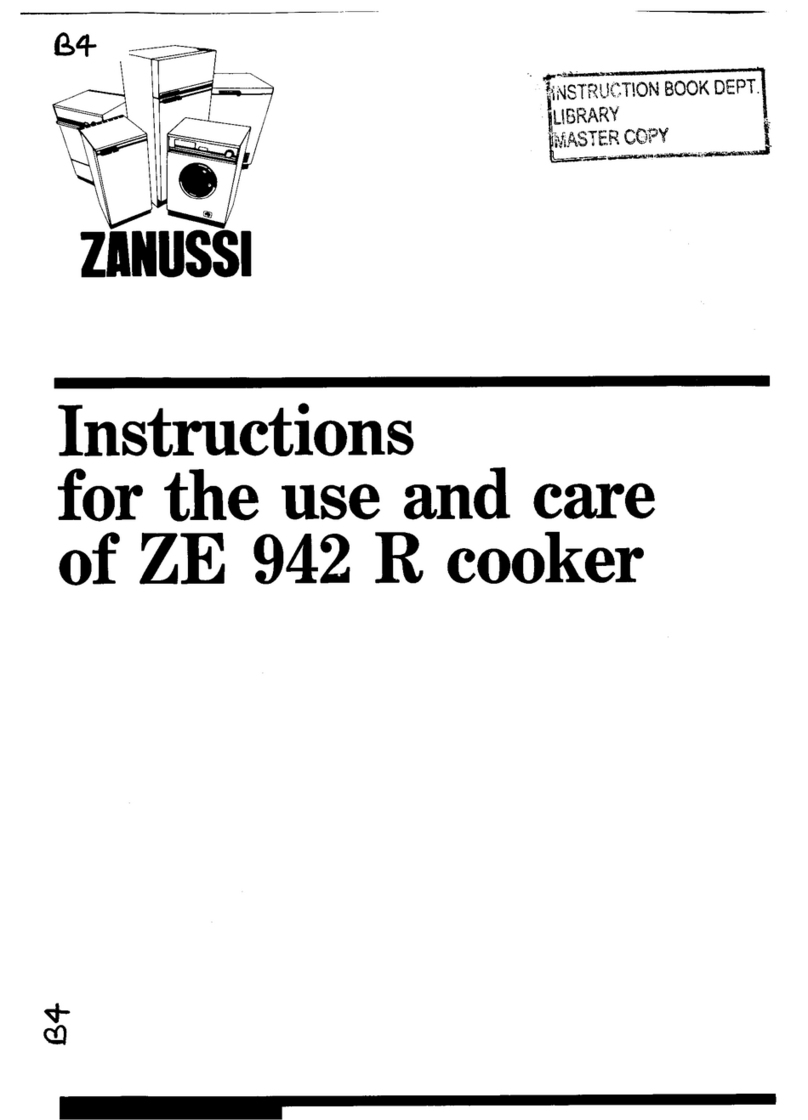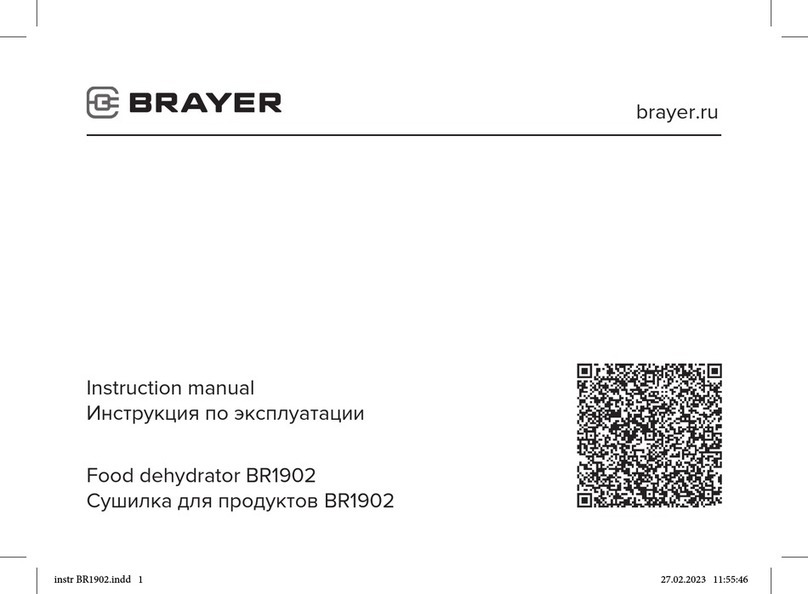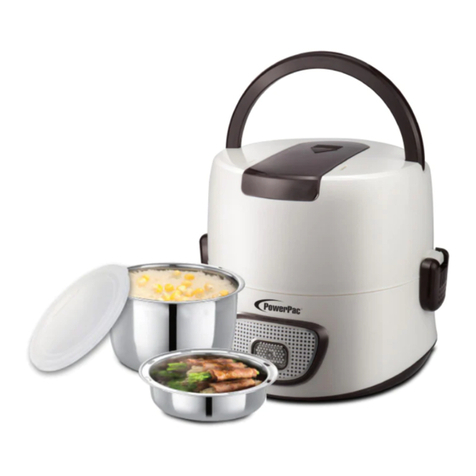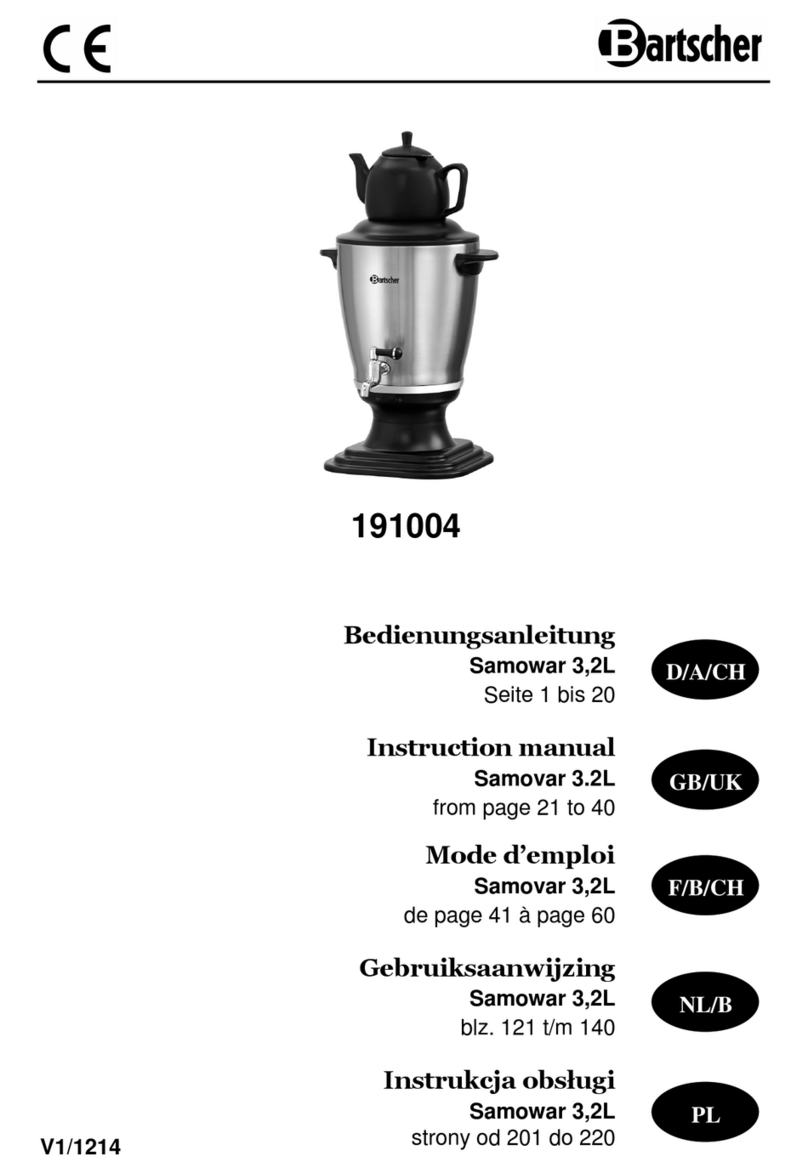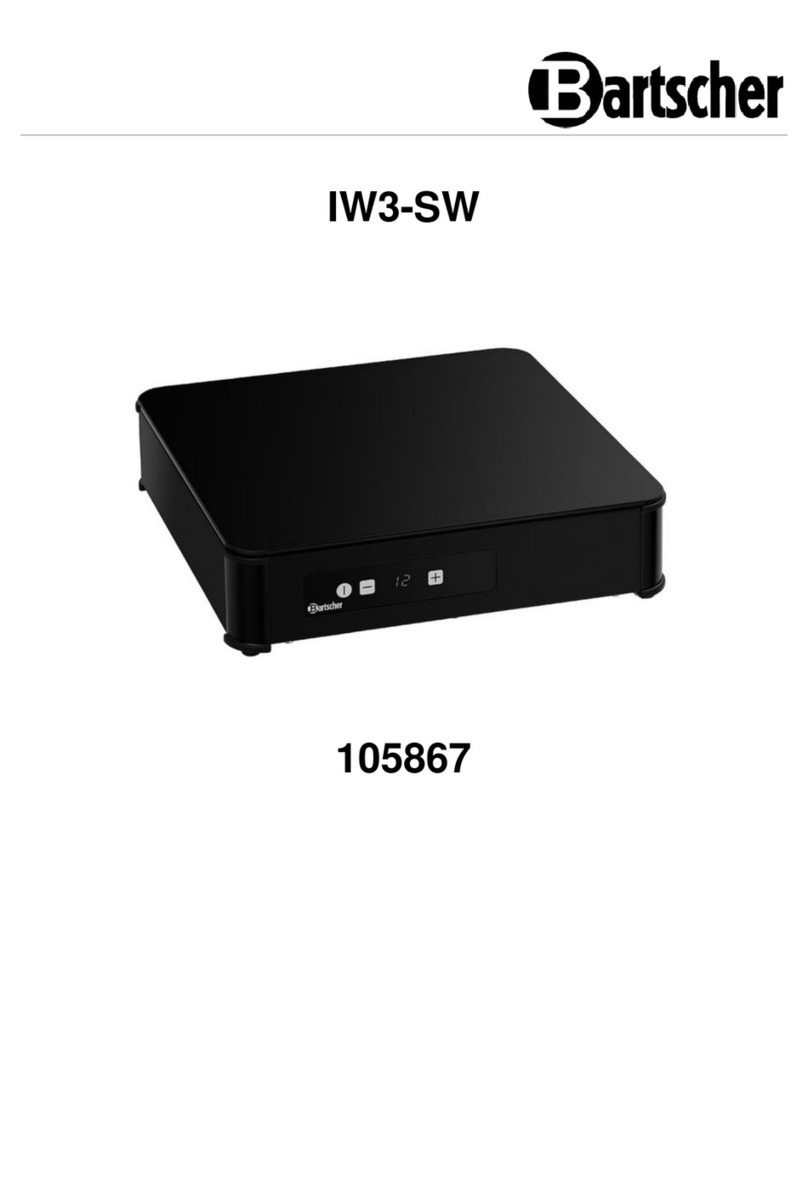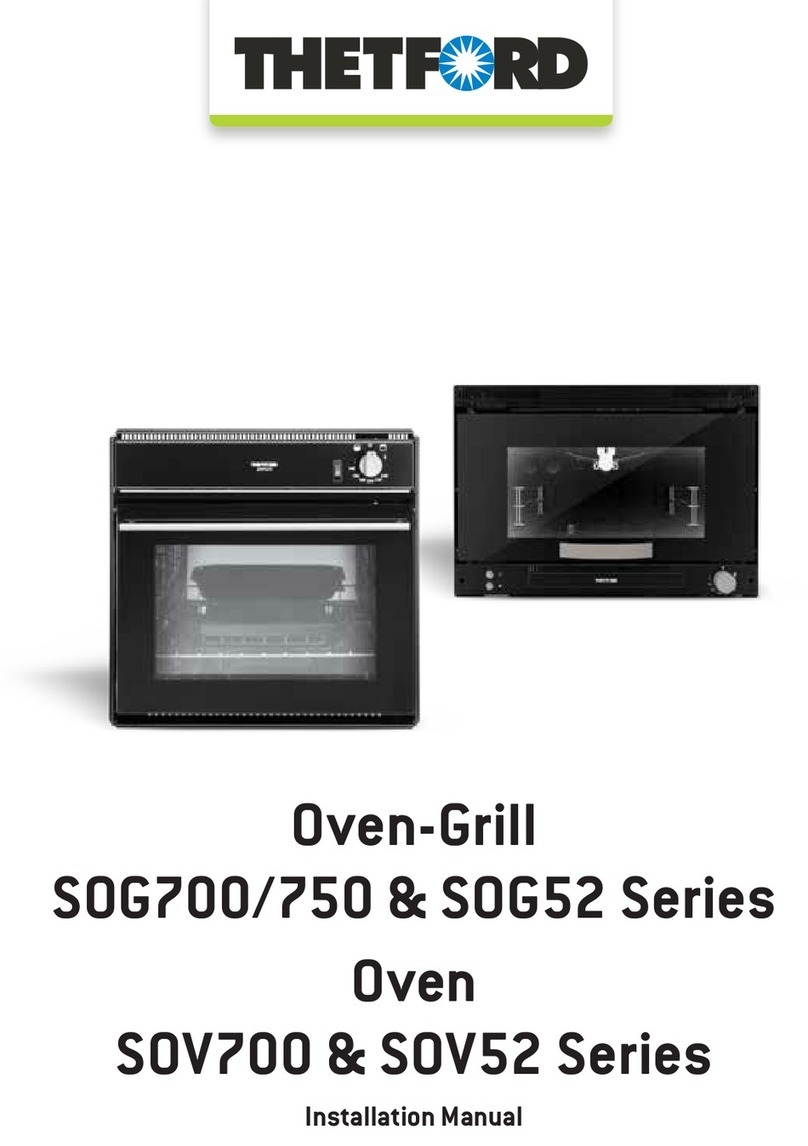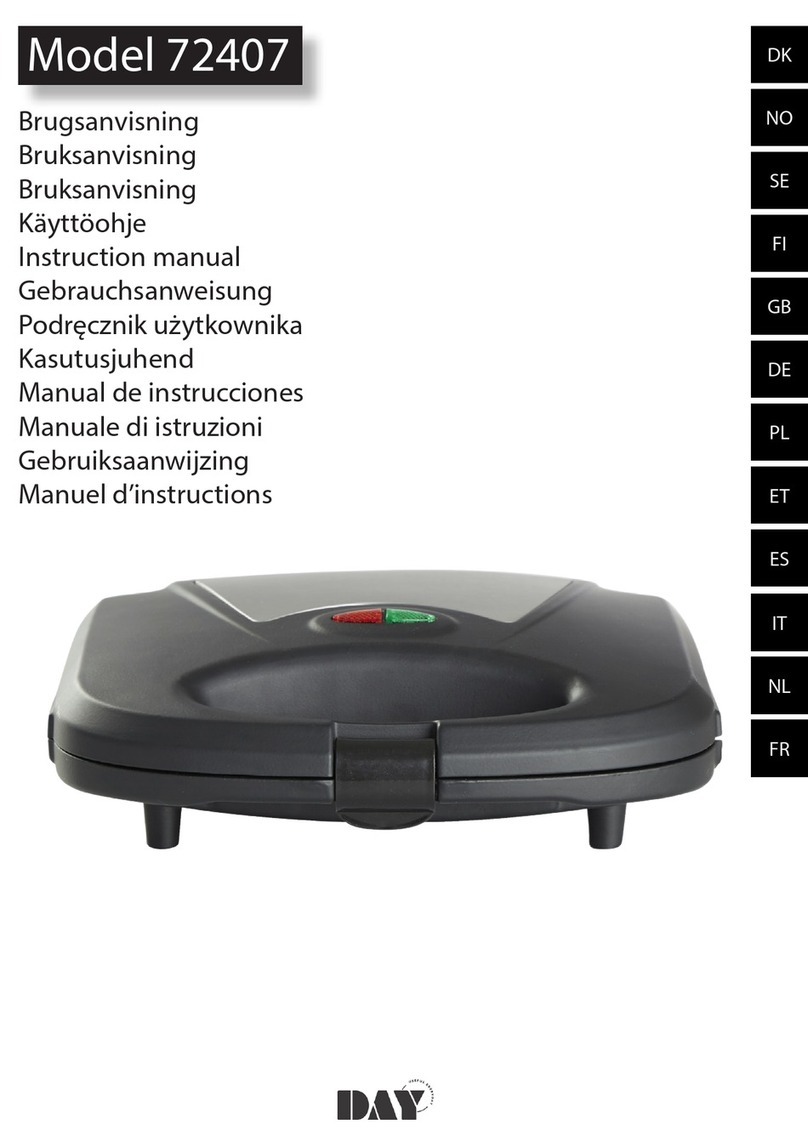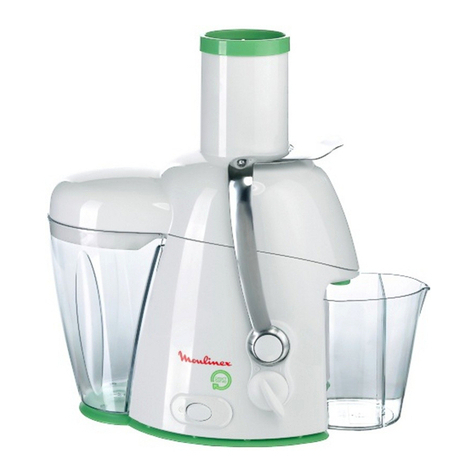Salvis Evolino II User manual

Cooking manual
Salvis Combi-Steamer Evolino II

Version 1.0 08/2008 Page 2 Cooking manual Evolino II
Index
Operating methods................................................................................................................................................3
Using the climates and functional components.....................................................................................................4
Area of application for Multifunction touch key......................................................................................................5
Combitronic®.........................................................................................................................................................6
Steaming...............................................................................................................................................................7
Steaming II............................................................................................................................................................8
Various steaming at low temperatures 30 - 98 ° C / 85 - 205° F..........................................................................8
Steaming at boiling temperature at 99° C / 210 F.................................................................................................9
Intensive steaming at 100 – 130° C /212 – 260° F............................................................................................10
Combi-steaming..................................................................................................................................................11
Convention / Hot air............................................................................................................................................12
Low temperature – cooking.................................................................................................................................13
Core temperature sensor....................................................................................................................................14
Roasting Methods...............................................................................................................................................15
The chemical-physical thermometer ...................................................................................................................16
Sous-Vide............................................................................................................................................................17
Capacity and preparations for meat- and meat products....................................................................................18
Capacity and preparation for sausages and hams..............................................................................................19
Capacity and preparation for game.....................................................................................................................20
Capacity and preparation for poultry...................................................................................................................21
Capacity and preparation for fish and seafood....................................................................................................22
Capacity and preparation for vegetables.............................................................................................................23
Capacity and preparation for vegetables II..........................................................................................................24
Capacity and preparation for side dishes............................................................................................................25
Capacity and preparation for baking products.....................................................................................................26
Capacity and preparation for dessertand sweets...............................................................................................27
HACCP- Documentation.....................................................................................................................................28

Version 1.0 08/2008 Page 3 Cooking manual Evolino II
Preface
The Combi-Steamer is the all-rounder and one of the most used appliances in the professional kitchens. His range of
application is almost unlimited in a modern kitchen: with changing trends in the food variety and in the preparation not to be
missed.
To use these opportunities we took care during the development of the Evolino series to have one of the easiest panels and
the highest user-friendliness.
Over and above that we give you more detailed information how modern treatments and food processes are done.
Being aware that cooking is something very personal, we would like to recommend you to take full advantage of the practical
and proved techniques.
Your benefits:
SIMPLIFIED WORKING METHOD
LESS SUPERVISION
QUALITY ASSURANCE, BETTER ENERGY AND TIME SAVINGS!
If necessary, allow yourself sufficient time to work out your own programs, or to adjust the memorised cooking programs
according to your own ideas and requirements.
With the best regards
Your SALVIS head chefs
Operating methods
Panel
Touch key
ON/OFF Touch key
Combisteam
Touch key
Hot air Time
Display Temperature
Display Core temperatur
e
Display
Touch key
Steam
Climate
Active
Touch key
Start /Stopp
Endless turning
knobs for:
Time
Temperature
Core Temp.
Manual
Steam injection
&
Preheat/
Cool down Multi select
button

Version 1.0 08/2008 Page 4 Cooking manual Evolino II
Using the climates and functional components
Steaming
Vario steaming
Intensiv steaming
Steaming- reheating big charges-
heating- conserving –thawing-hold –
sous vide- blanching –poaching-
Combi-steam
Gentle cooking- roasting- thawing-
reheating plates, banquet system and
GN trays- hold – heating
Hot Air
Roasting– crust baking – Grill –
Toasting – Baking – Gratinating
Manual steam injection
and preheat / pre-cool
Could be activated in the climates
steam combi-steam , hot air ,
Reheating and low temperature-
cooking
Clima-Aktiv®
Perfect climate due to dehumidification
Combi-steam 0/5/15/30/40/50%
Hot air activated to exhaust
Chef-or Multifunction touch key
Assignment options:
-Banquet / Regeneration
-Low T Cooking
-Delta-T Cooking
Factory setting!
Ex factory the function „rE“
(banqueting/reheating ) is automatically
set!
By turning on the combi-steamer and
activating the chef touch key the
temperature will be automatically set at
140°C and indicated in the temperature
display

Version 1.0 08/2008 Page 5 Cooking manual Evolino II
Area of application for Multifunction touch key
Choosing other
features
Switch on the combi-steamer
Press the and at the same time.
An acoustic signal will sound and the memory opens.
With the turning knob “time” the following features can be
programmed:
-Regenerating “rE”
-Low temperature cooking “lt”
-Delta T “dT”
Hold the Multifunction touch key to save the settings- a signal
will sound!
By starting the combi-steamer and choosing the Multifunction
touch key the programmed feature will appear by indicating the
temperature. Core temperature and time need to be adjusted
every time.
Multifunction key
assigned for
“Banquet /
Regeneration
rE" for Banquet / Regeneration
Press key. LED lights up. The temperature display shows
140°C (automatic default setting).
Temperature range: 90 to 180°C.
Additional functions: Steaming and humidifying.
Multifunction key
assigned for
“Lt Cooking”
"Lt" for Low temperature cooking
Press key. LED lights up.
The temperature display shows 80°C (automatic default
setting).Temperature range: 30 to 120°C.
Additional functions: Steaming and humidifying
Multifunction key
assigned for
“DeltaT Cooking
dt" for DeltaT Cooking
Press key. LED lights up. The temperature display shows 40°C
(automatic default setting). Adjust the delta between 30 and 40
to receive a perfect result
Entry field: The time diplay is enabled while working with core
temperature; adjust core temperature between to 99°C.
Additional functions: Steaming and humidifying.

Version 1.0 08/2008 Page 6 Cooking manual Evolino II
Combitronic®
Press the desired climate
steaming combi-steaming hot air multifunction
Adjust time by turning knob
Time range from 0:00 to 24.0 hours
*- - -* continuous operation
Adjust temperature by turning knob
Temperature range from 30° to 300°C or
Core temperature adjustable by turning knob
Temperature range between 20°-99°C
Press two or three climates touch keys at a time, the 4.step at the last moment. All climate
LED should glow.
A maximum of 4 operating methods can be quick-programmed, but only from left to right.
That means first steam/ combi-steam/ hot air and then a multifunction feature.
Press Start/Stop to start the programm.
All program steps start from the left to the right side
Area of application
Examples
Croissants unbaked frozen
1. Steam 110°C/2min
2. Combi-steam 150°C/8 min
3. Hot air 180°C/10-12 min
Veal shank
1. Combi-steam 180°C/25 min Humidity30%
2. Hot air 100°C/KT 68°C
Whole roasted duck
1.Steam 120°C/10min Humidity 100%
2.Combi-steam 175°C/50-60min Humidity30%
3.Hot air 190°C/20 min Humidity0%

Version 1.0 08/2008 Page 7 Cooking manual Evolino II
Steaming
General:
Conventional steaming at boiling temperature 99°C / 210° F is one of the most nutritious and gentle
methods of preparing food. Encircled by steam the food is cooked at constant temperature. Consistency and colours
are preserved. Products retain vitamins, flavour and natural taste.
Nutritional values remain intact and are not washed away by water or destroyed by excessive heat.
In principle everything that is normally boiled in water or any other liquid is steamed. All vegetables,
side dishes, and many fish and meat products are suitable. It is possible to cook at the same time
vegetables, potatoes, rice, meat and fish. There is no transfer as regards aroma and flavour from one
product to the other.
With the Evolino cooking in pressure less fresh steam at different temperatures:
Vario steaming at low temperatures 30 - 98° C / 85 – 205° F
Steaming at boiling temperature 99° C / 210° F
Intensive steaming at 100 -130° C / 212 – 260° F
Physical condition of water
Water appears in three different ways: aerially as steam, liquid as water and hard like ice. The transforming between these
three grades will appear through heating or cooling. Liquid water will boil at around 100°C. This temperature depends on the
atmospheric pressure. If the atmospheric pressure is lower - water boils at a lower temperature. So water will boil on top of a
mountain at 92-95°C. Liquid water will freeze at a temperature lower than 0°C. Also this temperature depends on the air
pressure that affects the water. Try following experiment. Take a conductor with weights on both ends and lay it over an ice
block-it starts to cut the ice. To lower the freezing temperature of water just add salt Snow and ice are lighter than water.
Energy transfer
In the different functional components of the combi-steamer the real cooking and colouring of products will affect trough energy
transfer.
Climate
Steam Energy transfer through condensation
Hot air
Energy transfer through irradiation
Moving air supports the cooking process as the heat / temperature is more
intensive and effective. Up to 25% more than appliances with standing heat
(traditional ovens, holdomat, alto-shaam)

Version 1.0 08/2008 Page 8 Cooking manual Evolino II
Steaming
Various steaming at low temperatures 30 - 98 ° C / 85 - 205° F
The perfect gentle cooking method for all sensitive foods
Meat
Scalding of ham and sausages, especially for butchers but also for
cooks who prepare their own sausages. They obtain top quality by
scalding their home-made sausages at low steam temperatures
between 72° and 80° C.
Fish
Fish is gently cooked in closed GN trays without additional stock.
Poaching delicate fish at temperatures between
75 – 85° C guarantees best results, no falling apart. Tureen dishes set
evenly.
Perfect diced custard – no problem - at about 80 °C.
Dessert Finely porous to smooth cut.
Desserts like cream caramel (caramel custard) or fruit compotes are
cooked gently and do not overcook at low steam temperatures. All
custards and creams are filled in moulds and covered with foil
afterwards.
Sous vide
Sous vide is high quality production of all kinds of food. But it needs a
high hygienic standard. Visit sous vide courses or invite an instructor!.
See also: "La Cuisine sous-vide"
from: Georges Pralus, France.
Be aware of hygienic regulations!!
Product Temperature Hints for production
Meat
Fish
Poultry
Vegetables
Fruits
Side dishes
80 – 98 ° C
70 ° C
70 ° C
90° C
90 ° C
98 ° C
Place the prepared food in special heat resistant Sous-vide
bags.
Vacuum to the maximum, for sensitive products use a
protection gas.
The higher the vacuum – the shorter the cooking time.
Vacuumed food needs to be placed on grids while cooking

Version 1.0 08/2008 Page 9 Cooking manual Evolino II
Steaming
Steaming at boiling temperature at 99° C / 210 F
Conserving
At a temperature at. 80° C all fruit, vegetable or meat conserves will succeed in a perfect
way. Up to the size of the product or glasses fruit conserves need about 20-60 minutes.
Meat products like sausages in natural/artificial bowel need 1-3 hours.
Thawing
In the low temperature range up to 95°C all products, except meat and fish will be thawed
in a gentle way , before using the in the traditional work process . The lower the
temperature the more gentle is the thawing process. The thawing time depends on the type
and consistency of the food.
Blanching
Scaled vegetables or salades before using them in other processes.
Vegetables
Decisive advantage: No more heating of boiling water, you start cooking right away.
Vegetables cooked in steam provide excellent retention of flavour, nutrients, colour and
aroma. Cooking times depend on the quality used, especially in case of fresh products.
Attention: Steamed vegetables continue cooking when removed! If you don't serve them
immediately, just cool them in ice or cold water.
We recommend perforated GN trays, so that the steam can penetrate from all sides.
Different kinds of vegetables may be cooked simultaneously; there is no transfer of aroma.
Don’t fill the deeper GN trays to more than 2/3 of their total height. Do not use vegetables
frozen in blocks!
Side dishes
Boiled potatoes should be salted before cooking in perforated GN trays. Cooking times
depend on quality and size.
Other side dishes such as rice and pasta must always be prepared in closed GN trays as
they need water for welling up.
Ratio rice: water = 1: 1, 5 to 1: 2 depending on the quality.
Cover pasta completely with hot water and stir from time to time.
Dumplings should be placed well apart as they rise. In case of ready-made products,
observe the manufacturer's instructions. In case they are set aside prior to serving, cover
the GN trays with foil or a lit.

Version 1.0 08/2008 Page 10 Cooking manual Evolino II
Steaming
Intensive steaming at 100 – 130° C / 212 – 260° F
Meat Meat is cooked gently and remains juicy and tender. Especially suited
for diet cooking.
Vegetables Stuffed vegetables cook gently and remain juicy, retaining flavour and
colour.
Regenerating/rethermalizing (large quantities).
Regenerating means re-heating of ready-made foodstuff. The integrated
live-steam generation helps to make food look and taste most
appetizing and fresh.
Regenerating Regenerating at high temperatures – intensive steaming - is used for
larger quantities of vegetables and side dishes.
Re-heating times vary between 3 and 8 minutes, according to product,
quantity and quality. If the pans are filled up too high or if the products
are placed too close, re-heating times will be longer.
Use intensive steaming to can, preserve or sterilize home-made dishes,
compotes or fruit.
Do not use too high or too big cans or jars.
Conserving
In the high temperature area between 100 and 130 °C
It’s also an opportunity to preserve fruits in cans, jars etc and to sterilize
them. Do not use too big containers as the outside of fruits could
overcook.
Cooking
To reduce the regular cooking times adjust higher temperatures for low
sensitive products like red beets, potatoes.

Version 1.0 08/2008 Page 11 Cooking manual Evolino II
Combi-steaming
General:
Combined cooking means that the two basic cooking methods, namely “steaming“ ( humid heat) and “convection“
(hot dry air) are automatically combined. Food is cooked in hot air (up to 250 °C) and
water is injected automatically into the oven cavity at regular intervals, enriching the hot air with humidity.
The advantages: Weight losses are minimised thanks to precisely dosed moisture.
The products remain soft and juicy but crispy and brown. No need to baste the meat.
It is possible to bake or roast different products simultaneously; there is no transfer of aroma.
In case a highly crisp skin is wanted, just change to “convection“ at the end of the cooking process or
use a Combitronic program “Combi steaming + Convection“.
Using hints
Meat All roasts and big poultry are cooked perfectly in the combi-cooking
mode combi-steaming.
Place roasts or poultry on trays or grids and make sure to
arrange them well apart, otherwise they will not brown at
points of contact
Poultry
Rule of thumb:
The bigger the roast - the lower the required temperature.
Per 1 cm thickness about 10-12 minutes cooking time.
For the preparation of sauces/gravy, just collect the dripping fat and
juice in a closed pan placed underneath the grid; add roots, bones and
some water or wine.
Use the stock to prepare whatever sauce/gravy you want.
Regenerating Regenerating/rethermalizing of cold precooked food arranged on plates,
dishes or in bowls – the new trend (banquet system).
As soon as a meal is required for eating, it is a simple process to
rethermalize it at temperatures of about 110-130 °C / 220° - 270° F,
there is no difference between fresh and rethermalized food.
Times for rethermalizing depend on quality, size and height of
containers (plates, dishes, bowls, pouches etc.) and on the combination
of the meal. When thawing deep frozen meals in pouches or containers
the temperature should not exceed 90° C /200 ° F

Version 1.0 08/2008 Page 12 Cooking manual Evolino II
Convention / Hot air
Common:
Convection is the ideal mode for baking, roasting, broiling and grilling in hot air, consequently for all products that want crispy
and brown outer skins. On several levels baking, roasting and gratinate simultaneously is possible.
By all means pre-heat the convection steamer so that the cooking process starts immediately after charging, thus keeping the
inside juicy and tender.
Using hints
Sautee-dishes
Roasting, broiling and grilling in hot air give the professional touch to
small pieces of meat or fish, such as meat or fish fillets, cutlets,
escallops etc.
For breaded products use whatever breadcrumbs you like. Add a little
mild paprika to the mixture to make the pieces look appetisingly brown.
Roast on grids except for meals made of minced meat; those should be
fried on trays. All meat and fish pieces, especially breaded ones, should
be brushed with melted butter or oil, so that they can brown evenly.
Best quality and appearance is reached when you start roasting by first
frying them in a pan or on whatever grill at high temperatures for a very
short time. It is also possible not to finish them completely but leave
them to cool and finish roasting later.
Poultry
Small poultry can be used fresh or deep frozen.
Dry poultry carefully, season, brush with fat and place on grids
Gratinating
Use hot air/convection to gratinate soups, toasts, meat, fish and
vegetables. Place on pans or trays so that the heat comes mainly on
the surface.
Baking
Do not forget – Preheat the oven
Set the temperature approximately 10% lower than for traditional
ovens. Pastries, cakes and bread remain light and golden brown.
The lower the temperature the more uniform is the baking result.
Use the fat filter even when baking, with the exception of big trays, big
cakes and bread loaves.
Place moulds and flan rings on grids and make sure to have sufficient
clearance.
For enriching the hot air with humidity you may press the key for
manual steam injection at the beginning of the baking process

Version 1.0 08/2008 Page 13 Cooking manual Evolino II
Low temperature – cooking
Common:
With the low temperature cooking method (lt-cooking) all kind of food are cooked with lightly humid an reduced fan speed
chamber climate
The “lt “-cooking contains two phases:
1. A higher temperature to start the cooking process and to coagulate the proteins on the surface of the meat/fish
2. The lower second phase to ripen the meat. The meat gets extra tender and stays juicy even if kept warm for several
hours
The low temperature cooking is also recommended for overnight cooking processes.
Please be aware of the health regulations and do not store sensitive products unattended in the combi-steamer.
Product Cooking hints Climate Cooking and
core temper.
Cooking time Weight
Roastbeef
Season and brush
with oil
+
„lt“
160
cT 60
15 min
min. 1 h.
4 kg-
pieces
Braised beef
Season and brush
with oil
+
„lt“
160
ct 85
15 – 20
min
min. 6 h
6 kg-
pieces
Prime Rib
fresh
+
„lt“
160
ct 60
20 min
min.4
1 pc per
GN 1/1
Beef top round
Season and brush
with oil
+
„lt“
130
ct 60
30 min
min. 6h
About
8kg
Whole turkey
season
+
„lt“
130
ct 70
45 min
min. 2-3 h

Version 1.0 08/2008 Page 14 Cooking manual Evolino II
Core temperature sensor
With the core temperature sensor the temperature in the middle of the product will be determined accurate.
This way it will result always the same perfect way. The roasting process doesn’t’ need to be supervised and overcooking is
impossible.
As soon this option is chosen, the time display indicates continuous operation. As soon the selected temperature
is reached, the appliance will turn off- except another cooking phase is programmed with the Combitronic®-
The metal point of the sensor should be completely placed in food to be cooked. (up to the handle)
The temperatures are guideline values, differences are possible through meat quality, preferences and
cooking process. Keep the temperature low, to lower the loss of weight trough the cooking process.
CORE TEMPERATURE – GUIDELINE
Beef and Veal
Beef tenderloin ………………40 – 55° C
Braised beef. ..................... ............................................................85 – 90° C
Boiled beef ……………….90 – 95° C
Veal tenderloin ......................50 – 55° C
Veal strip loin ……………….50 – 55° C
Roast veal ……………….68 – 74° C
Stuffel veal breast ……………….75 – 80° C
Porc and Lamb
Whole ham …..……….…..67 – 69° C
Porc roast ……………….70 – 75° C
Por striploin ……………….55 – 60° C
Porc shoulder ......................65 – 75° C
Bonelless porc belly ……………… 75°C
Rind less shank ......................85 – 90° C
Kassler ......................60 – 68° C
Pork ham for coldcut ……………….58 – 60° C
Leg of lamb ……………….65 - 70° C
Leg of lamb well done ……………….80 – 85° C
Game and Poultry
Interlarded venison striploin ......................50 – 56° C
Roasted venison ……………….75 – 80° C
Whole chicken ......................80 – 85° C
Duck ......................80 – 90° C
Turkey ......................80 – 90° C

Version 1.0 08/2008 Page 15 Cooking manual Evolino II
Roasting Methods
Roasting range: Conventionally roasting: Temperature range between 140°C and more
Roasting in the oven
Cooking time between 1.5 -2 h
Roasting with low
temperatures Temperature range between 140°C -80°C
Cooking time between 2-4 h
normal ripened meat
External (quick) roasting recommended, after the
cooking process.
Long term cooking: Temperature range between 100°C -80°C
(only for fresh slaughtered meat 48h
Do not use any salt, season without salt
External roasting after the cooking process
recommended
Reduce fan speed
Cooking time about 4 - 8 Std. + Holding
Hold 5°C above the core temperature
Delta-T: The Delta T cooks by maintaining a constant
temperature differential between the foods
internal temperature and the temperature in the
cooking cavity of the oven.
As the probe senses the internal product
temperature increase, the Delta T raises the oven
cooking temperature.
We don’t set cooking time or cooking temperature;
we simply set the Delta T differential and the target
internal temperature.
The Delta T feature will always be used with the
probe.
Delta T reduces shrinkage by cooking with
lower and gentler heat
Cook and Hold: The Cook & Hold-Program offers you the
opportunity for food components, which are already
produced and ready to serve, to hold in a variable
temperature between 30°C and 120°C. The
cooking chamber humidity in the cook & hold
program is also selectable from von 0% until 100%.
To reduce the danger of overcooking in the hold-
mode, please adjust the hold-temperature only as
high as the definite core-temperature of the product
and reduce the holding time to a minimum.

Version 1.0 08/2008 Page 16 Cooking manual Evolino II
The chemical-physical thermometer
280°C
to 300°C
Salamander-heat while gratinating
250°C
High oven temperature
170°C
Average oven heat (acryl amide-building temperature)
160°C
to 240°C
Temperatur for saute dishes
160°C
to 175°C
Deep frying
150°C
Up to 250°C
Grill temperature
150°C
Up to 200°C
Caramelizing ham
140°C
Up to 250°C
Baking in an oven
140°C
Up to 200°C
Braising in an oven
140°C
to 160°C
Lightly brown stewing
130°C
to 150°C
Blanching in oil
120°C
to 140°C
Stewing
110°C
to 250°C
Roasting in an oven
110°C
Low oven heat
97°C
to 120°C
Steaming in a pressure steamer 1 bar = 119°C
100°C
Blanching in water
95°C
Natural starches like potatoe-rice-tapioka coagulate
80°C
to 98°C
low temperature cooking
88°C
to 92°C
Infusion for tea and coffee
85°C
Washing temperature for dishwasher machines
80°C
to 90°C
Core temperature for pork and poultry
75°C
Starch binding material coagulate
75°C
Core temperature “well done”
70°C
Reheating pre cooked meals
70°C
Egg yolkes coagulate
65°C
to 85°C
Poaching
65°C
Proteins coagulate
60°C
to 65°C
Pasteurizing temperature
60°C
Core temperature “medium”
50°C
Eating temperature
50°C
Core temperature “rare”
45°C
Core temperature "bleu"
10°C
to 50°C
Plus humidity = Bacteria’s best growing climate
7°C
to 9°C
Best storage temperature for potatoes
4°C
to 6°C
Best storage temperature for fruits
3°C
to 5°C
Best storage temperature for potatoes cooked products
0°C
to 3°C
Best storage temperature for meat, fish and milk products
-18°C
to -22°C
Best storage temperature for frozen products
-40°C
to -60°C
Best storage temperature for blast chilling

Version 1.0 08/2008 Page 17 Cooking manual Evolino II
Sous-Vide
Sous vide is a professional cooking method which employs plastic oxygen barriers and precise temperature controls to reduce
oxidization and extend the useable shelf life of inventory by diminishing contact with aerobic bacteria. The result is a final
product with superior texture, amplified flavours and enhanced organoleptic qualities.
Only the freshest, highest-quality ingredients must be used when preparing sous vide packages. This can significantly lower
initial microbial levels, extending shelf life and product freshness.
It is also critical to calibrate equipment on a daily basis and quality-check all seals and packages for leaks.
Raw packets must not be stored for more than two days before pasteurization above 60°C (140°F), and must be cooled below
3°C (37°F) within two hours.
Pasteurized inventory should be stored below 3°C (37°F) and consumed or frozen within a specified time period.
The date and time of packaging, pasteurization, and expiration must be documented and labelled on the package.
Recommendation:
Visit a solide sous vide training course
Start with small samples an create own recipes
Gain experiences and plan the production
After a solid test phase with different food products start with the real production series
The use of this method requires the following features:
The freshest products and ordering at the time needed
Detailed planning of the production ways
Tested and certified recipes
Briefed employees which are aware of the danger
Strictly regulated HACCP standards – regularly control checks
Regularly quality checks
Storage at the right temperature at 1-3°C¨
The reheating happens the optimum way in a combi-steamer or pressure steamer. Single portions are also to heated up in a
microwave oven.
On demand the food will be heated up directly on a plate or in the sous-vide bag.
The sous-vide method is a fundamental way for permanent hygiene and quality saving. They keep their natural colour,
freshness and form. They also will convince with higher nutrition content. The intensive flavour of the food allows using only
half of the seasonings than traditionally used, including salt.

Version 1.0 08/2008 Page 18 Cooking manual Evolino II
Capacity and preparations for meat- and meat products
Use the climate combi-steam to preserve the most humidity .
Alternatively you’re able to use hot air with the manual steam
injection .
Minced meat and
other product Phases Temperature Humidity Time Core
temperature Additional features
Meat loaf 1
2
160°C
170°C
40%
0%
---
---
65°C
75°C
Use a greased
closed enamel tray
Hamburgers 1
200°C 0% 10-15min --- Use a greased
closed enamel tray
Stuffes bellpeppers 1
160°C
30% 35min
Use a GN tray
closed, 65mm.
Cook in a spicy and
good flavoured
sauce.
Fleischkäse 1
2
130°C
130°C
30%
0%
15min
---
---
70°C
Add on a grid, by
using a meat loaf
pan of 2kg or to
your preference
Lasagne 1
2
155°C
170°C
50%
0%
30min
10min
Use a greased
closed 65mm
enamel tray. Do not
overfill. Extra: use
a savoury cheese!
Vegetable casserole
1
2
150°C
175°C
40%
0%
30min
10min
Use a greased
closed 65mm
enamel tray and fill
with egg-cream
liaison
Potatoegratin 1
2
160°C
170°C
50%
0%
25min
15min
Use a greased
closed 65mm
enamel tray and
dredge with
parmesan cheese
Quiche Lorraine 1
2
180°C
200°C
40%
0%
25min
30min
Use a greased
closed 65mm
enamel tray season
the sour cream-egg
liaison well

Version 1.0 08/2008 Page 19 Cooking manual Evolino II
Capacity and preparation for sausages and hams
Use a 100% steam for this kind of product.
Alternatively you ‘re able
to use the combi-steam with a humidity of 60%- 100%
Sausages and hams
Phases Temperature Humidity Time Core
temperature Additional
features
Frankfurter 1
80°C 100%
15min GN trays closed
cover with stock!
Weisswürste 1
78°C 100%
25min GN trays closed
cover with stock!.
Black sausage /
pudding
Liver sausage
1
75°C 100%
--- 72°C GN trays closed
cover with stock!
Cold cut sausage
(Lyoner)
1
75°C 100%
--- 72°C GN trays closed
cover with stock!.
Boiled ham 1
75°C 100%
-T 50-60°c
humidity 100%
72°C GN trays closed
cover with stock!
Cure the ham
before
Knuckle of pork 1
100°C 100%
95°C GN trays closed
cover with stock!
Cure the ham
before

Version 1.0 08/2008 Page 20 Cooking manual Evolino II
Capacity and preparation for game
Recommended Climate : Hot Air/Convention.
Game Phases Temperature Humidity Time Core
temperature Additional
features
Leg of venison
meduim 1
120°C 0%
60-70min 58°C Place on a grid
and bard with a
very thin slice of
white bacon.
Marinate and use
a piece of string
to tighten the
meat.
Loin of venison
medium 1
180-200°C 0%
--- 52-55°C Place on a grid
and bard with a
very thin slice of
white bacon.
Marinate and use
a piece of string
to tighten the
meat. Spread
some squeezed
juniper berries on
top
Leg of deer 1
120-140°C 0%
90-120min GN tray closed 65 mm. Braise with
Mirepoix, juniper berries, laurel and
whole black pepper in a game stock.
Rabbit loin 1
200-220°C 0%
18-25min Place on a grid and bard with a very
thin slice of white bacon. Marinate
and use a piece of string to tighten
the meat.
braised leg of
wild rabbit
1
130-150°C
Combi-steam
30%
45-60 min Place on a grid and bard with a very
thin slice of white bacon. Marinate
and use a piece of string to tighten
the meat.
This manual suits for next models
1
Table of contents
Other Salvis Kitchen Appliance manuals

Salvis
Salvis VitalityEVO-Pro User manual
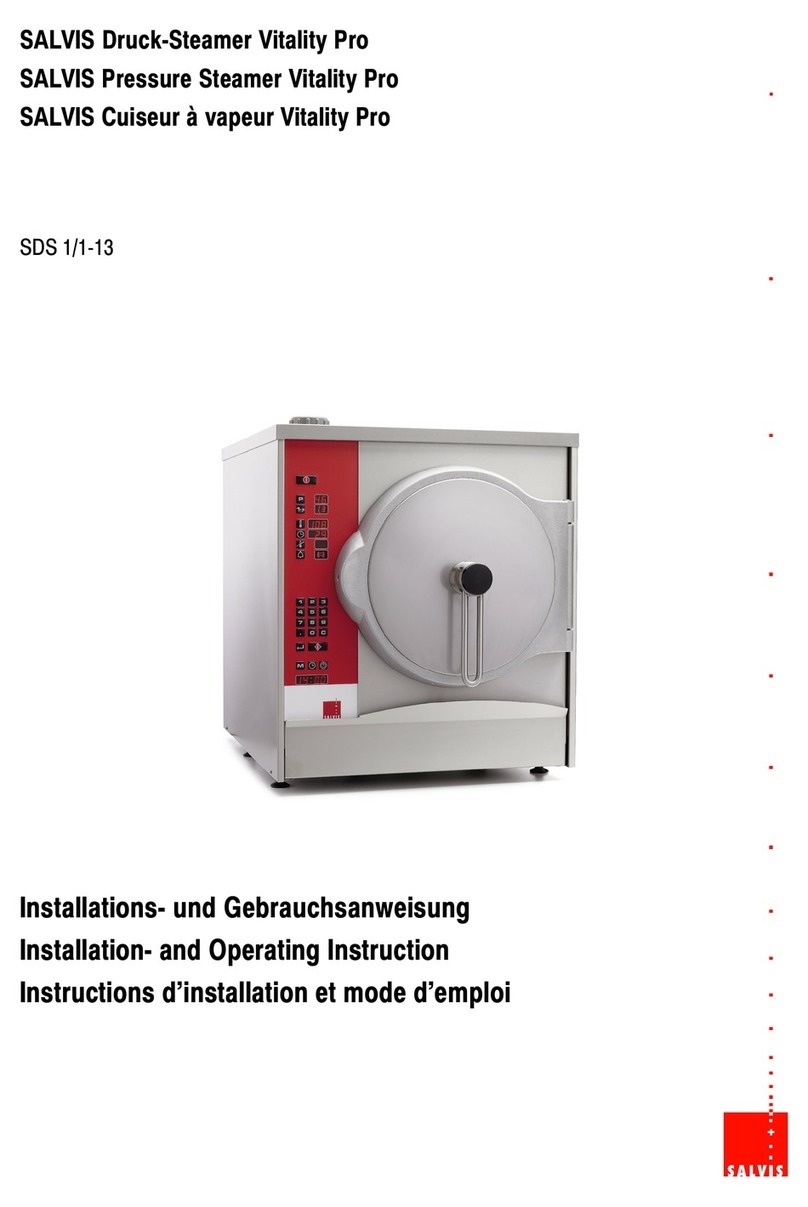
Salvis
Salvis Vitality Pro SDS 1/1-13 User guide

Salvis
Salvis ProfiLine Griddle plate 600 User manual
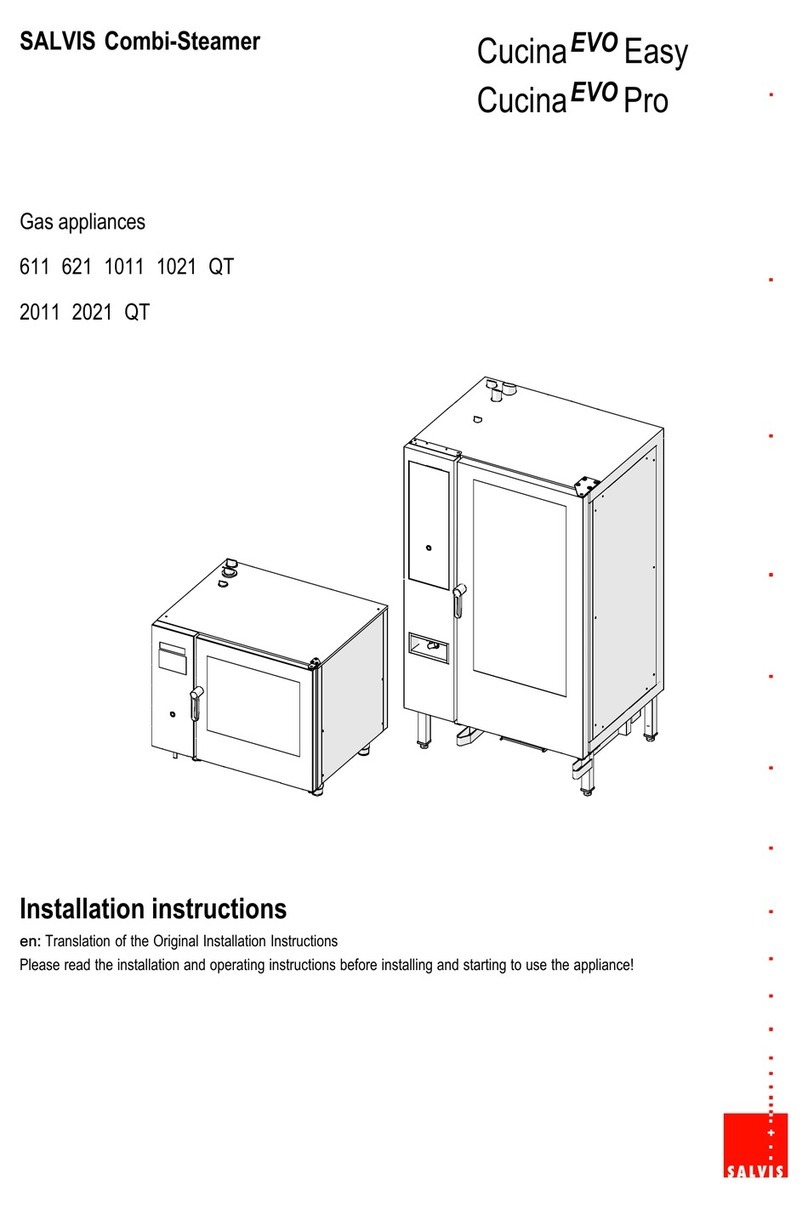
Salvis
Salvis Cucina Evo Easy Series User manual
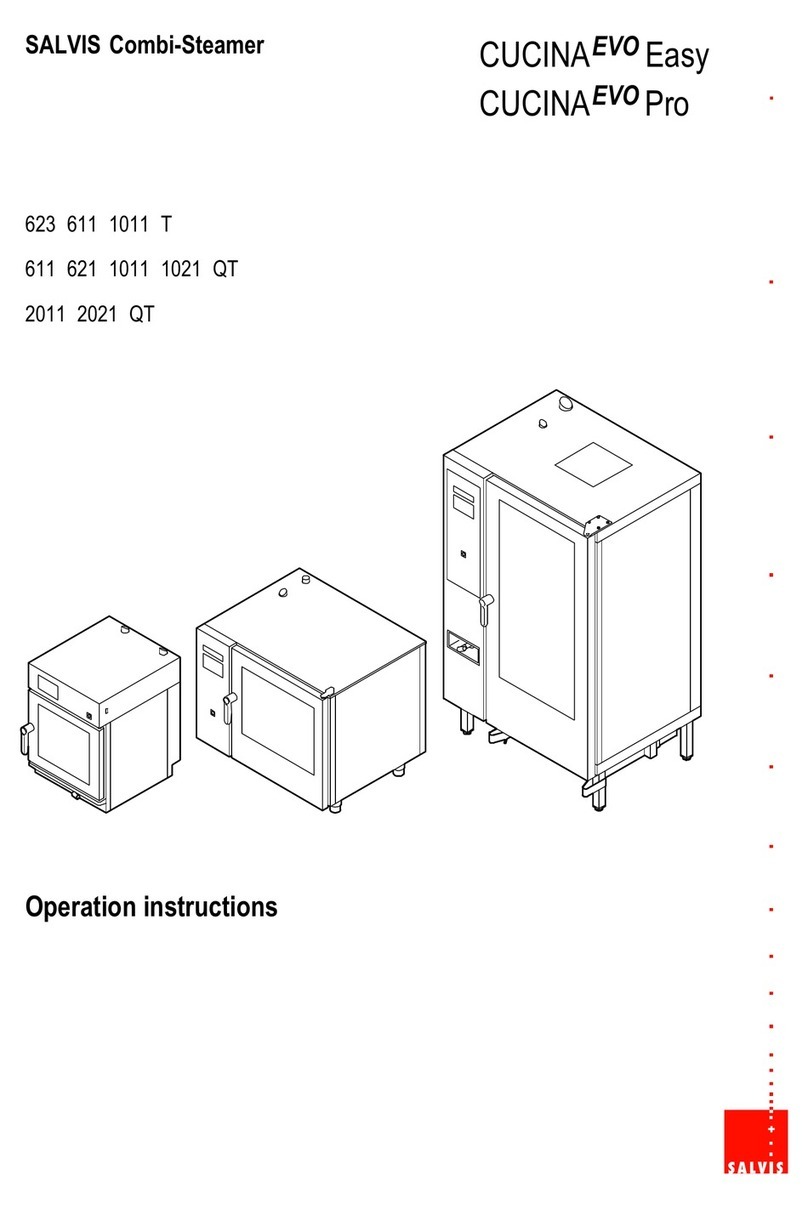
Salvis
Salvis CucinaEVO 623T User manual
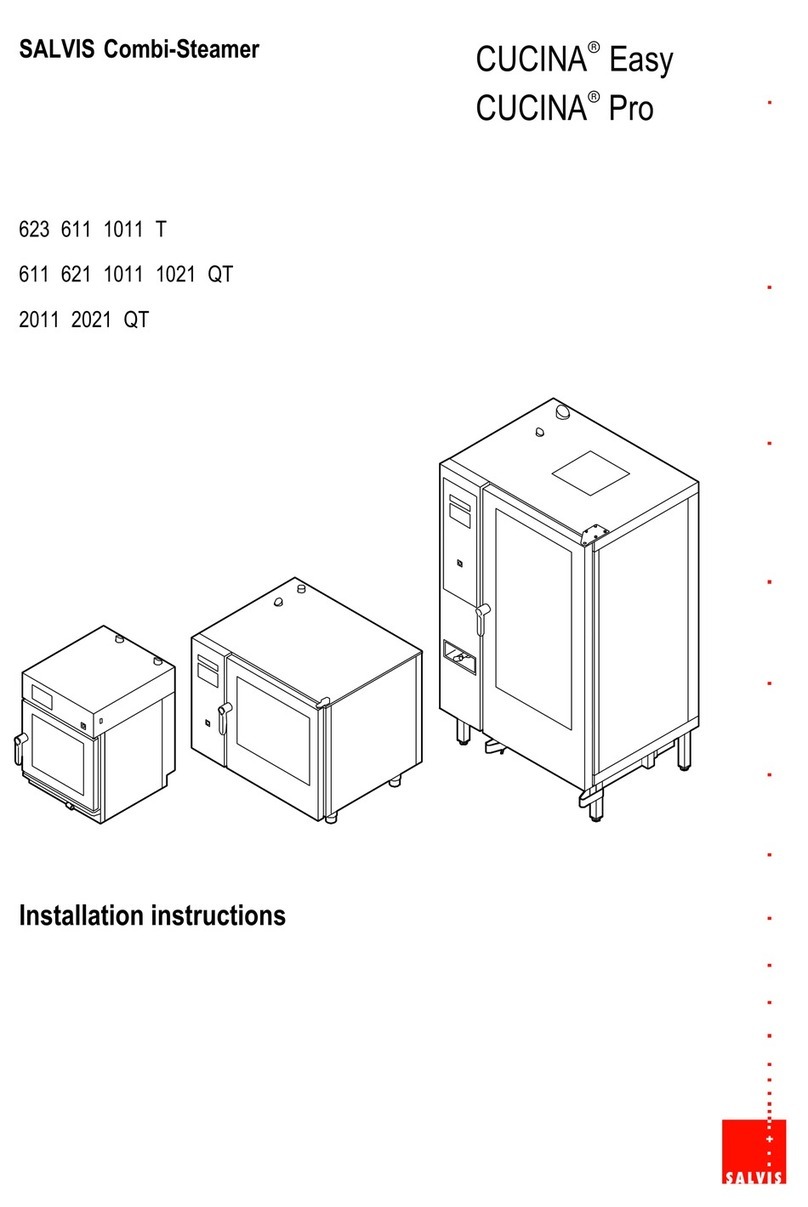
Salvis
Salvis CUCINA EASY User manual
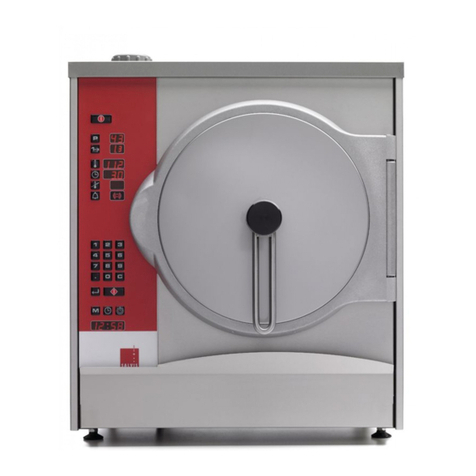
Salvis
Salvis FS 1/1 P User manual
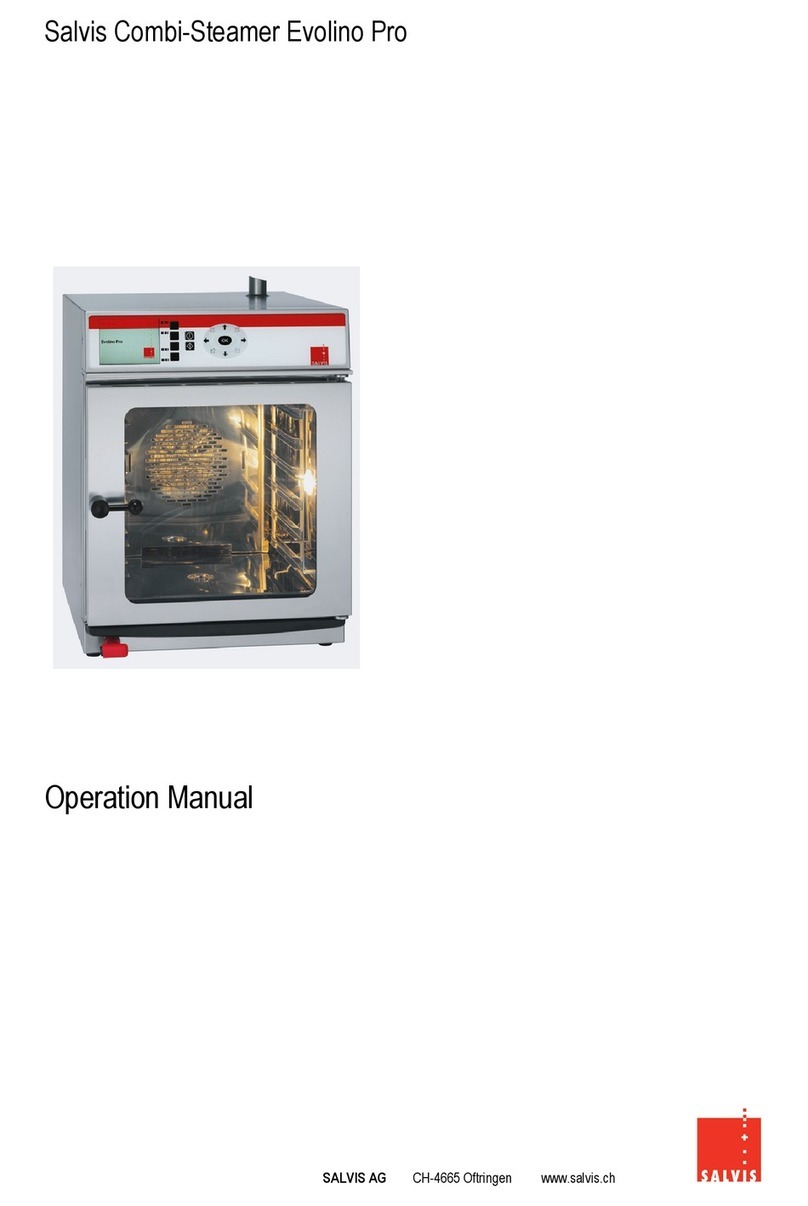
Salvis
Salvis Evolino Pro User manual
